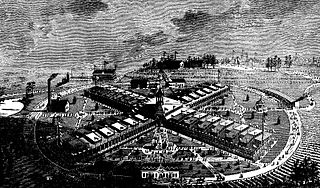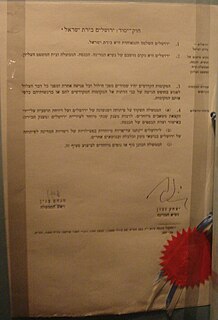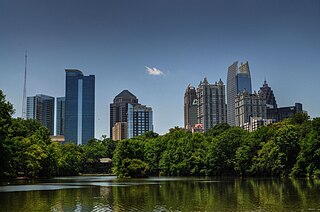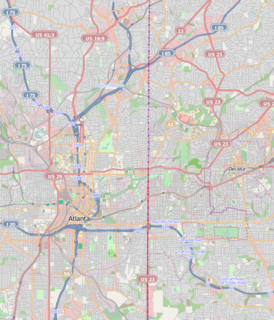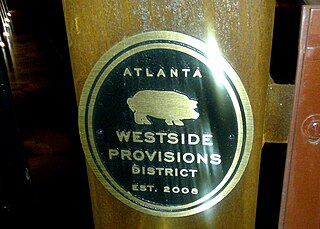Marietta Street Artery (formerly designated as "Bellwood") is an officially defined neighborhood of the city of Atlanta, Georgia, [1] part of the West Midtown area of Atlanta, also known as the "Westside." [2]

Atlanta is the capital and most populous city in the U.S. state of Georgia. With an estimated 2017 population of 486,290, it is also the 38th most-populous city in the United States. The city serves as the cultural and economic center of the Atlanta metropolitan area, home to 5.8 million people and the ninth-largest metropolitan area in the nation. Atlanta is the seat of Fulton County, the most populous county in Georgia. A small portion of the city extends eastward into neighboring DeKalb County.

Georgia is a state in the Southeastern United States. It began as a British colony in 1733, the last and southernmost of the original Thirteen Colonies to be established. Named after King George II of Great Britain, the Province of Georgia covered the area from South Carolina south to Spanish Florida and west to French Louisiana at the Mississippi River. Georgia was the fourth state to ratify the United States Constitution, on January 2, 1788. In 1802–1804, western Georgia was split to the Mississippi Territory, which later split to form Alabama with part of former West Florida in 1819. Georgia declared its secession from the Union on January 19, 1861, and was one of the original seven Confederate states. It was the last state to be restored to the Union, on July 15, 1870. Georgia is the 24th largest and the 8th most populous of the 50 United States. From 2007 to 2008, 14 of Georgia's counties ranked among the nation's 100 fastest-growing, second only to Texas. Georgia is known as the Peach State and the Empire State of the South. Atlanta, the state's capital and most populous city, has been named a global city. Atlanta's metropolitan area contains about 55% of the population of the entire state.
West Midtown, also known as Westside, is a colloquial area, comprising many historical neighborhoods located in Atlanta, Georgia. Once largely industrial, West Midtown is now the location of urban lofts, art galleries, live music venues, retail and restaurants.
Contents
The neighborhood consists of Marietta Street and the city blocks immediately to the east and west of it, stretching from 8th Street NW on the north to North Avenue NW on the south. It is bordered by the neighborhoods of Home Park on the north, Georgia Tech on the east, downtown Atlanta on the south, and English Avenue on the west. [3]

Marietta Street is a historic street in Downtown Atlanta. The street leads from Atlanta towards the town of Marietta, as its name indicates. It begins as one of the five streets intersecting at Five Points, leading northwest, forming the southern border of Downtown's Fairlie-Poplar district, continuing through Downtown's Luckie Marietta district, then entering West Midtown's Marietta Street Artery neighborhood, until terminating at its junction with West Marietta St., Brady Ave., and 8th St.
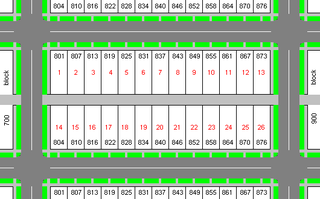
A city block, urban block or simply block is a central element of urban planning and urban design.

North Avenue is a major avenue in Atlanta, Georgia that divides Downtown Atlanta from Midtown Atlanta. North Avenue stretches continuously in Atlanta from Candler Park in the east, across Interstate 75 & Interstate 85, along the southern boundary of the Georgia Institute of Technology, to Joseph E. Lowery Boulevard just southwest of Georgia Tech, where it ends. North Avenue passes through the neighborhoods of Poncey-Highland, Old Fourth Ward, and Midtown Atlanta.
The neighborhood consists of many former industrial and warehouse properties which have been transformed into lofts, galleries, theaters, shops, restaurants, and coffee shops.

A factory or manufacturing plant is an industrial site, usually consisting of buildings and machinery, or more commonly a complex having several buildings, where workers manufacture goods or operate machines processing one product into another.

A warehouse is a building for storing goods. Warehouses are used by manufacturers, importers, exporters, wholesalers, transport businesses, customs, etc. They are usually large plain buildings in industrial parks on the outskirts of cities, towns or villages.

Renovation is the process of improving a broken, damaged, or outdated structure. Renovations are typically either commercial or residential. Additionally, renovation can refer to making something new, or bringing something back to life and can apply in social contexts. For example, a community can be renovated if it is strengthened and revived.


